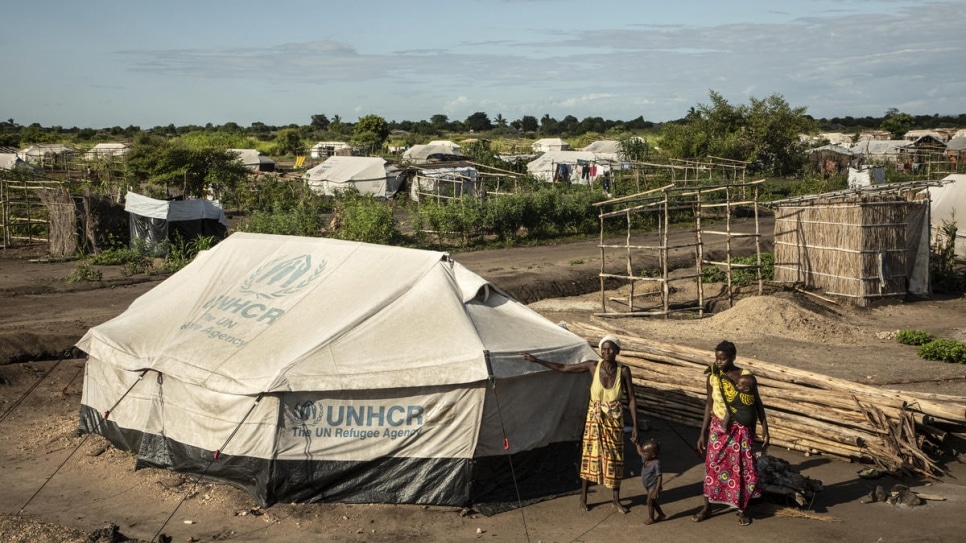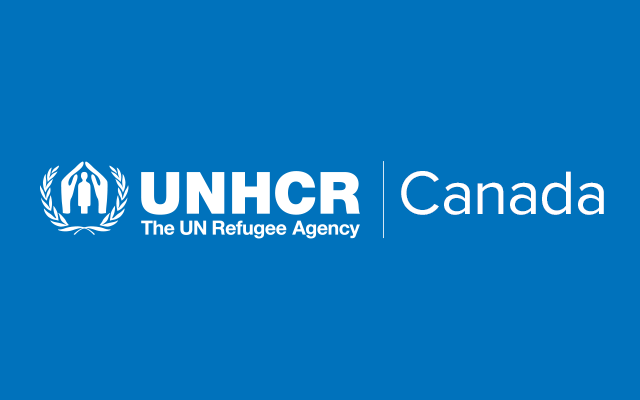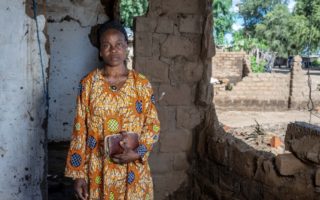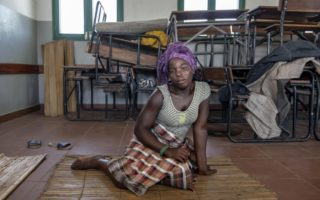
A family displaced by Cyclone Idai stand in front of their tent in Savane settlement, Mozambique. © UNHCR/Hélène Caux
Survivors in Mozambique are still trying to rebuild their lives. More assistance is needed to help them recover, and to support other countries affected by climate change.
By Catherine Wachiaya in Beira, Mozambique
When Cyclone Idai struck Mozambique a year ago, fisherman Jose Martinho fled to higher ground. He saved his life, but lost everything he owned. The government resettled him and his family inland, but he regularly goes back to his old neighbourhood, where he works fixing fishing nets, despite his fears.
“I lost my fishing nets and my canoe. I was left with nothing. My home was destroyed,” he said, his eyes fixed warily on the sea just metres from a shack he rebuilt with old, rusty iron sheets left scattered by the cyclone.
“But I am here because I need to take care of my family.”
Idai struck Mozambique on last March 14, and more than 600 people died in that country, Malawi and Zimbabwe. Cyclone Kenneth struck weeks later, and in all about 2.2. million people were displaced. Climate change and the country’s long coast along the Indian Ocean make Mozambique even more prone to cyclones.
UNHCR, the UN Refugee Agency, stepped in to help with the response, working closely with other aid agencies. Jose and his family were eventually transferred some 54 kilometres from Beira, the capital of the Sofala province, to Mutua resettlement site, one of six across the region most affected by the cyclone.
“The world must not forget the people affected by Cyclone Idai.”
Over 93,000 people were moved to these sites where UNHCR and other humanitarian agencies continue to help them. UNHCR provided shelter and relief items and monitored and counselled survivors, particularly children, women and the elderly. The emergency is over, but the refugee agency says more needs to be done if they are to recover fully.
“The world must not forget the people affected by Cyclone Idai. Yes, they received assistance, but they still need more help. They still need jobs, they need to rebuild their lives … their homes and they need their children to go to school,” said Ivone Kachidza, UNHCR’s Senior Protection Assistant based in Beira.
“Most of these people lost everything,” she said. For now, conditions at the resettlement sites are tough. There are no hospitals nearby, only basic health centres. Women give birth in tents and children must walk long distances to school.
“Life was good before the cyclone.”
Amelia Elias, a mother of three who lives in one of the sites, knows the problems firsthand. Before Idai, she and her family rented a house in Beira with furniture and a television and they were saving to buy their own place. She had a business and her husband also worked.
“Life was good before the cyclone,” said the 26-year-old. “Life here in the settlement is difficult because we can’t work, we have no means to live.”
Memories of what happened are still fresh.
Jose remembers how it began, with a radio announcement warning residents about the cyclone. Rain fell and the wind blew stronger than he had ever seen, but he said people were skeptical because they had survived cyclones before.
“If the cyclone comes back again I will try to run.”
“I was at home when it started at around 7 pm. It got worse and worse,” he said. Then, he added, “water was coming fast from the sea. Roofing sheets were blown from houses.”
Jose grabbed his family and joined others running from the storm, seeking higher ground. They spent the night at a school before being transferred to the Samora Machel accommodation centre where they received hot food and shelter.
Jose is happy that his family is safe, but faces a dilemma as he stitches his nets a few meters from the ocean.
“Living conditions in Mutua are very difficult. Being here by the sea is where I can manage to get something for my children,” he said. “I am scared. If the cyclone comes back again, I will try to run.”
Originally published by UNHCR on 13 March 2020





